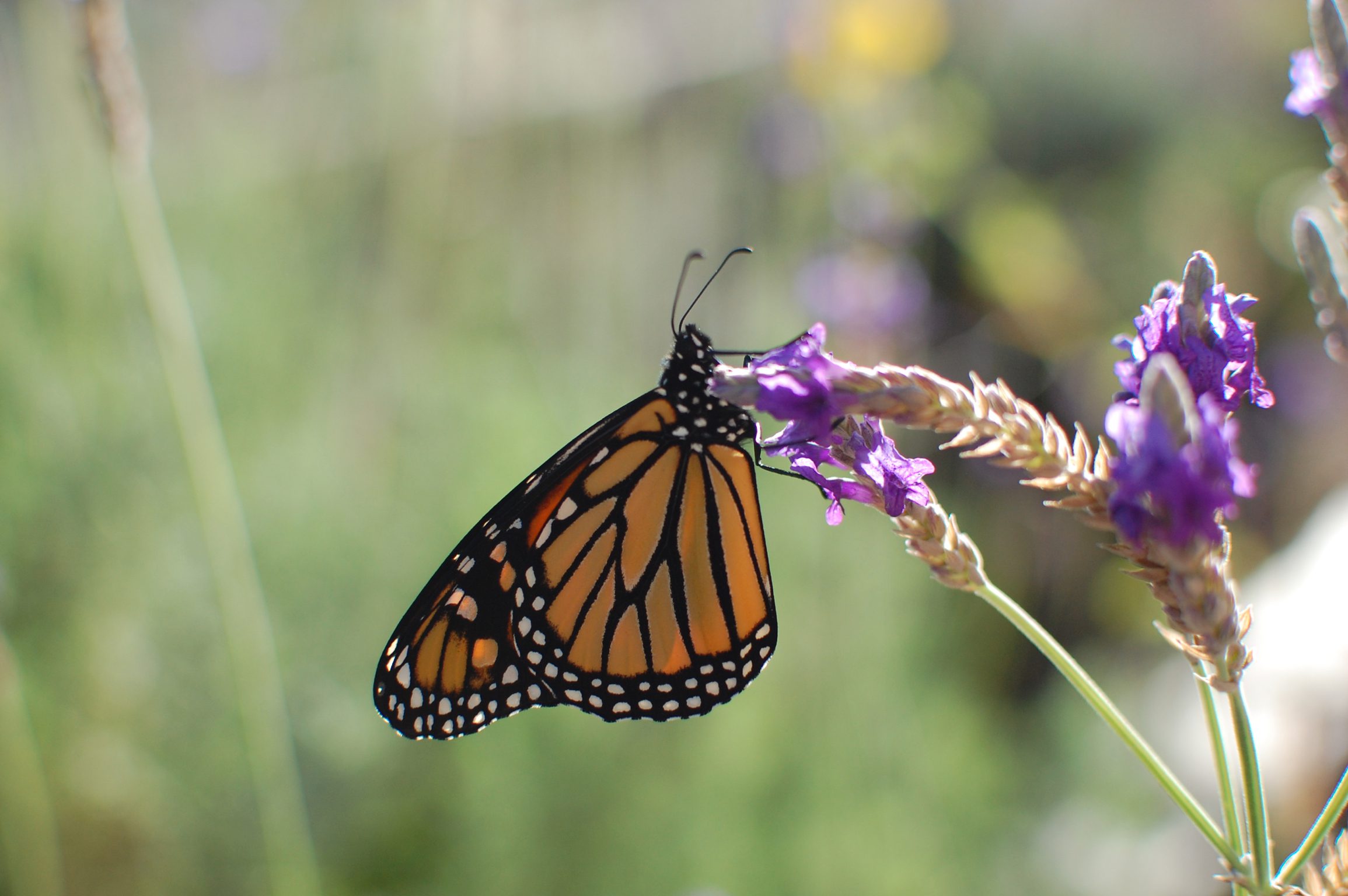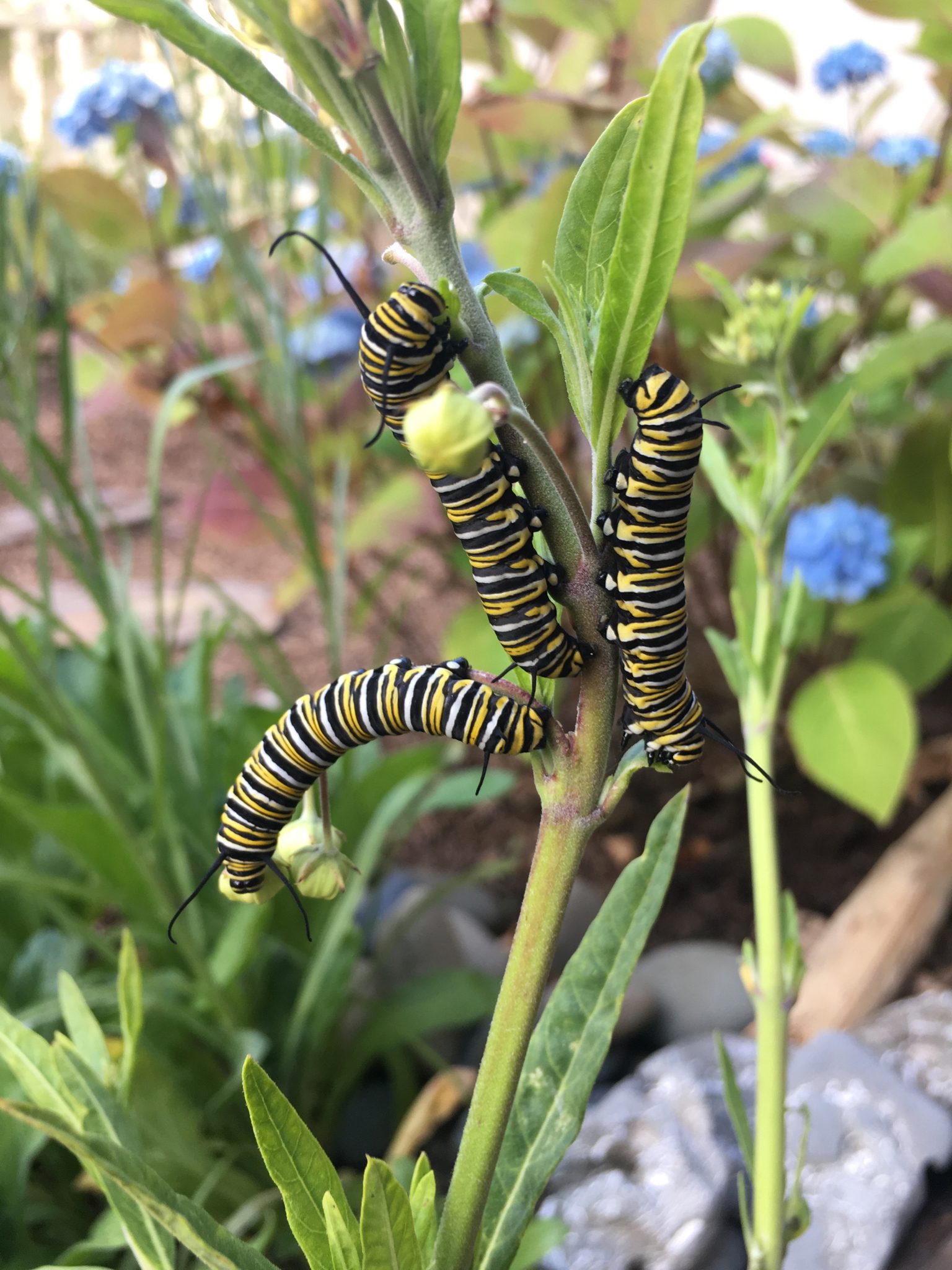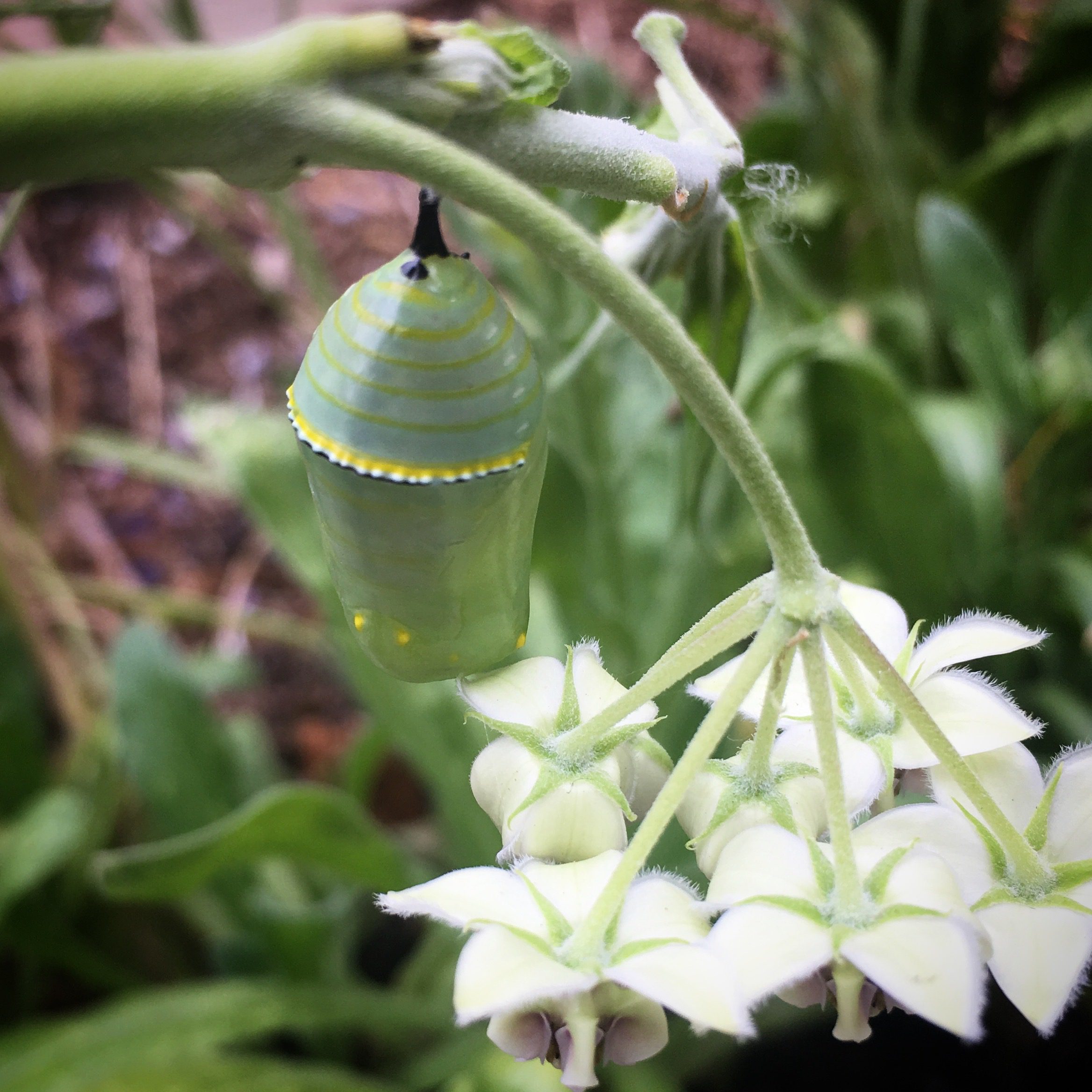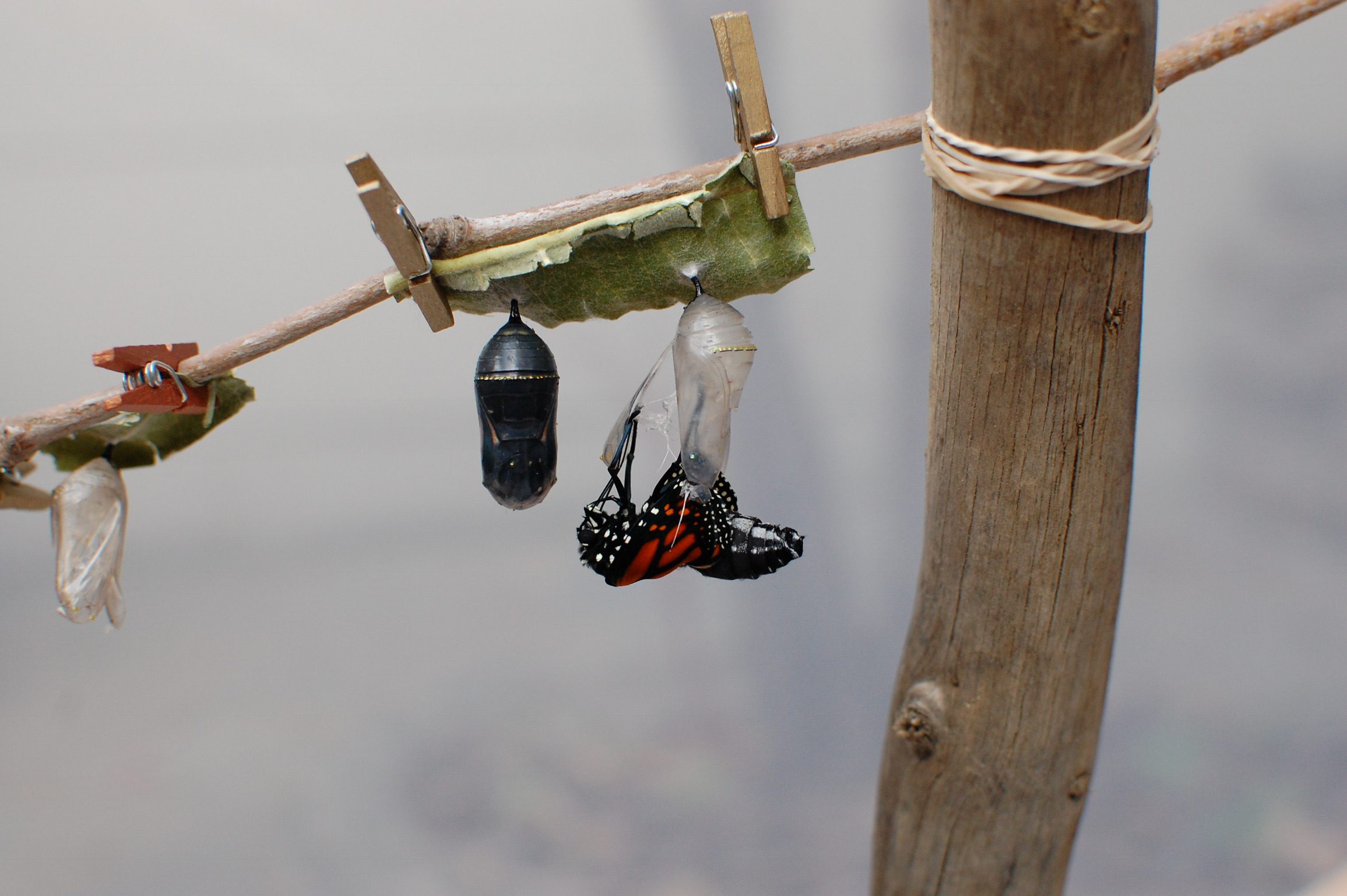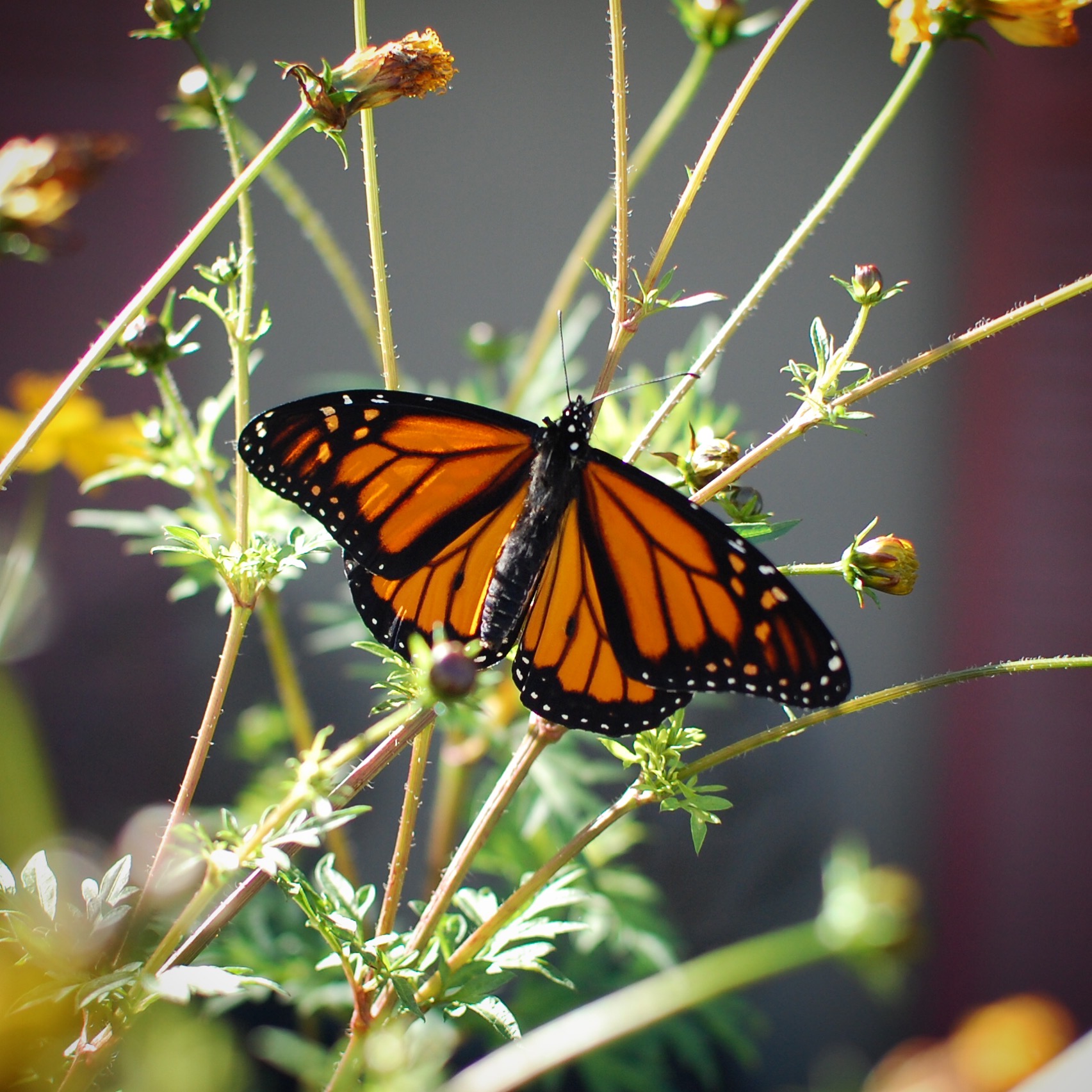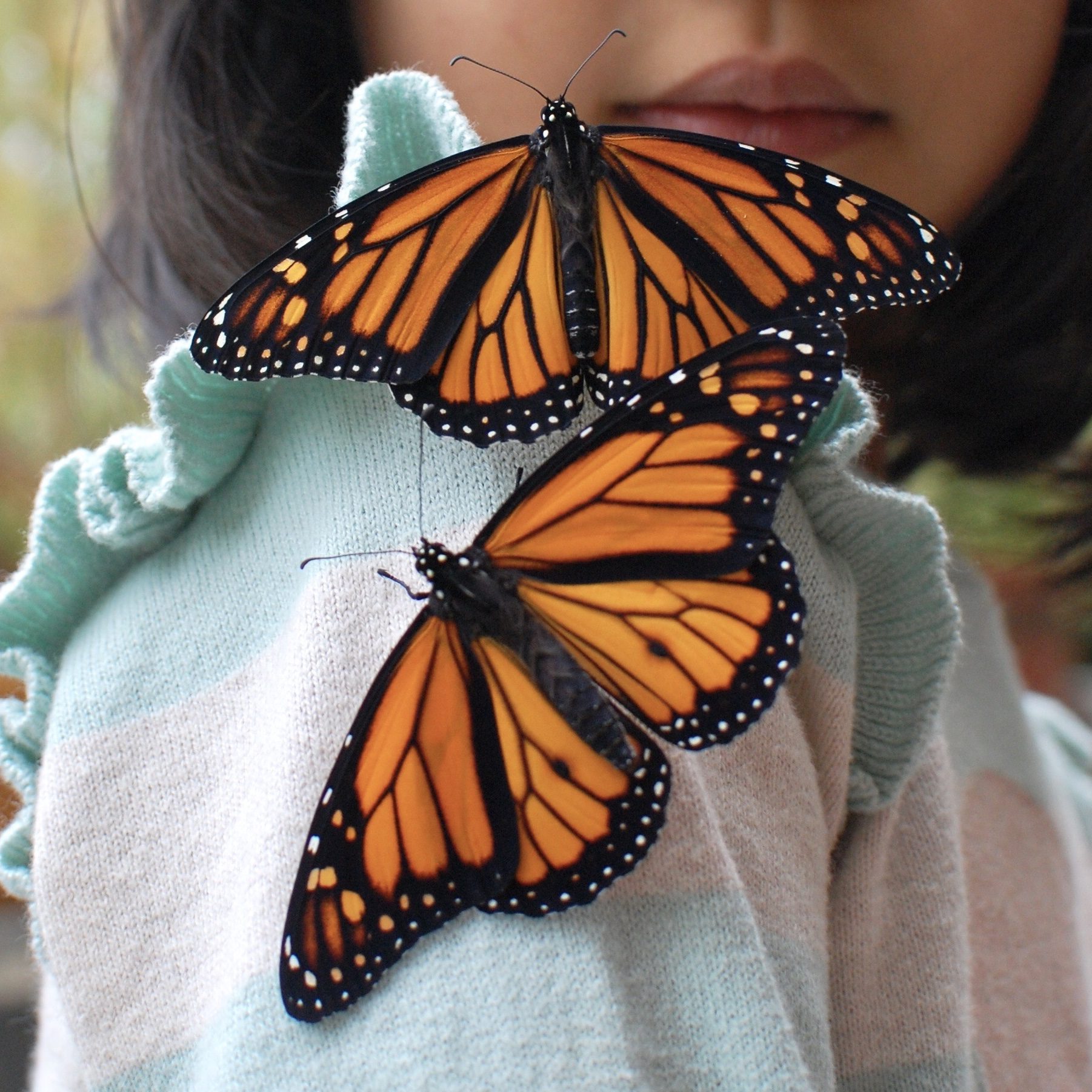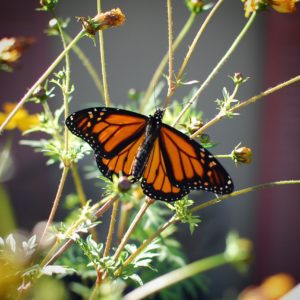
“Don’t get too attached to them. They are insects at the bottom of the food chain. Most of them will die,” advised a friend who had far more experience than I in raising many different plant and animal species. I had just planted milkweed in hopes of attracting and raising monarch butterflies. My tender heart couldn’t contain the anticipation that these butterflies might visit my garden and lay eggs, a feeling that almost reminded me of the months before my daughter, and then two years later, my son, were born and changed everything.
It was already too late.
Even before the moment I first saw one perfectly iridescent egg barely the size of a pencil-tip nestled on the underside of a milkweed leaf, I was more than attached. I was mesmerized. How did the mighty monarch butterfly evolve to rely upon milkweed, a single plant species, to arm their baby caterpillars with all the toxins and nutrients they need to survive? How do such tiny caterpillars completely transform into butterflies and migrate across the continent, through borders, mountains, farmland, and concrete jungles? How have we allowed this species and their miraculous migration to be on the brink of collapse?
During the depths of winter, when the daily onslaught of news revealed new levels of human-inflicted horrors, I read a different kind of story—about the plight of the monarch butterfly: once so numerous they filled the skies with gold during their epic migration across the continent, but now facing extinction. Among other conservation efforts, home gardeners planting milkweed along the monarch butterflies’ migration routes were making a difference in stemming their population decline.
These butterflies needed help, and I wanted to deliver them my garden.
I didn’t know what to expect at the time. I had been so absorbed in the daily tasks of raising children while sustaining a career and my relationship with my partner, Amado. I was on the moving walkway that begins with pregnancy and sleep deprivation, then labor and delivery, diapers and breastfeeding, toddler tantrums and preschool, and onto the next and the next.
There was no room for anything beyond breathing, commuting, grocery shopping, and squeezing in sleeping. The fog around my head began clearing, at times, after my youngest turned two. All of a sudden, I’d find myself at dusk, alone, out in the fresh air with my hands in the dirt, planting seeds, pulling weeds, swatting mosquitos from my face, focused, refreshed, and invigorated. Minutes became hours, weekend plans were scrapped, and dinners cut short because Mama had work to do in the yard.
Gardening became my daily therapy—a slice of time to do something that made me feel a sense of accomplishment and purpose.
In early February, when the mild Bay Area weather was chilly and the days still short, Amado cleared dirt as hard as a rock and dug up tangled, prehistoric-looking weed roots in our small, neglected yard. I carved a path for milkweed and flowers for the butterflies and bees. In the evenings, my daughter Kaia, then four, kept me company outside, coloring in her notebook with a blanket draped over her lap. On the weekends, she and my two-year-old son Leo made mud pies and poked pill bugs in the dirt.
We piled into the minivan and drove to nurseries in search of milkweed. While I wandered the aisles immersed in a whole new world of pollinator gardening, Kaia and Leo played among the rows of plastic pots, chased the nursery cats, and looked forward to the snacks they knew I tucked in my purse.
With the whole family plugged into the task, our small pile of clay dirt came alive that spring, teeming with sweet scents and surprises. We were giddy each time a seedling pushed its first little leaf out of the soil. The cosmos seeds we started in trays in our windowsill grew “taller than Daddy!”
The one seed that refused to sprout was milkweed, the sole food source for the monarch caterpillar and the only plant on which monarch butterflies lay eggs. This once plentiful “weed” is now in steep decline because of the widespread use of pesticides and urban development. I read everything about milkweed, including how to mimic winter in the refrigerator for its seeds to germinate (sprout), how to not disturb its roots, how it may die early in its first year but come back more vigorously in its second.
I planted at least two hundred seeds, some in little egg carton pockets and some directly in the ground. I waited. The garden sprung to life with not a single milkweed in it. Bees buzzed, cute-faced brown butterflies zipped around, and ladybugs, salamanders, and earthworms joined, too. This all brought unexpected daily delights, but as summer approached I felt time slipping away. The enigmatic monarch butterfly—the creature that we created this garden for—had yet to make an appearance.
I finally treated myself to over a dozen milkweed plants from the nursery. There was no more time to waste with my seed-starting endeavors. Two weeks later, I saw orange flutter by our window. Was my eager mind playing tricks on me again? A spider caught my eye on a small milkweed plant, still in its plastic container on our front porch. When I looked under the leaves, I found not one but two tiny monarch eggs. I almost cried. I brought them inside, away from spiders, wasps, ants, and the rest of the predators that contribute to their two-to-three-percent survival rate in the wild.
To our delight, more monarch butterflies laid eggs in our garden throughout the summer. Their wings were faded with tears and holes and looked like they had traveled a great distance. My heart broke a little each time I caught a glimpse of these winged mothers’ almost unbelievable strength, purpose, and resilience. In an instant, she would be gone, but what she left was her precious, promise-filled egg in the lush crevices of the milkweed plant.
Monarch mothers may lay a whopping five hundred eggs over the course of two to five weeks—further contributing to my endless awe and admiration for the species. Kaia, with her keen eyesight and low vantage point, spotted tiny eggs underneath the leaves and brought them inside. I doted on the caterpillars that I lovingly referred to as my “little larvae,” and the kids learned about pollination, the life cycles of butterflies, and the critical role they play in our ecosystems.
To watch a monarch caterpillar evolve feels like witnessing an otherworldly transformation.
It first emerges from its egg so tiny you must squint to see it. Over the next few days its body becomes chubby and vibrantly striped. Black antennae-like “filaments” pop out of its head and appear to feel around in the air. It eats, poops, sheds its skin, and grows until it is so plump that it appears it may burst. It then stops eating and crawls for hours, searching for the perfect upside-down spot where it stays for a day. It spins a silk ball, attaches itself, and hangs in a “J” position, incredibly vulnerable, for another day. It darkens in color and its skin splits open, revealing a lime green blob, twisting and contorting itself to completely shed its blackened skin. It then becomes a regal green chrysalis, edged with gold that sparkles during the day and shimmers when it catches moonlight.
Caring for these captivating insects brought a spiritual presence to my life: a daily meditation; reverence and wonder; a new awareness of breath, earth, microorganisms, exoskeletons; a stillness, all while getting lost in utter enchantment by a species that can be reborn and the earth that it came from. For two weeks the chrysalis hangs like a teardrop made of jade, motionless and smooth. Under the surface, everything is breaking down and transforming. Does it know what it once was? How could it possibly know what it is becoming?
This period of apparent stillness and “in between,” while everything underneath is preparing for transformation, deeply resonated.
As a sleep-deprived parent and sometimes-scattered person, big decisions loom at every turn. I often must charge forward in this life, despite constantly second-guessing, hesitating, and not knowing. As my children grow, as my career unfolds, as my parents age, as financial pressures get heavier, as I find a new sense of self at every turn, I often look back wistfully, wishing I could pause for just a little while before the next big change.
Then, one day, the monarch’s hardened chrysalis turns black as midnight. Orange wings appear within. The chrysalis skin becomes a paper-thin shell that is shed for the last time as a huge, velvet black butterfly emerges, hanging upside down, pumping fluid into its expanding wings. Hours later, those powerful wings begin to flap, and the mighty monarch soars high in the sky, out of sight, and into the great mystery of its migration.
There is no looking back, only forward—purposefully and tenaciously, transformed and reborn. It is magic in real life.
“Mama, our first monarch butterfly came out!” Kaia squealed as I pulled up after work one summer day. We stared at the butterfly’s gorgeous wings with their perfect pattern of white dots, as if the goddess Mother Nature painted them herself. Leo, who was barely learning to talk, called it a “bubba-tie.” I asked Kaia what its name should be. “Pollinator,” she replied, very matter-of-fact. “How about Polly for short?” I asked. “No, Mama, that is a name for a bird. This butterfly’s name is Pollinator.”
Over the next few months, we raised over fifty “Pollinators.” We sat together in the early mornings with the butterflies on our fingertips. Some were immediately ready to take flight, others lingered, and one or two had a hard time flying at all. The longer a butterfly stayed on our hands, the more concerned we grew about its ability to fly the great distance. Kaia, whose heart is as big as the ocean, was particularly concerned about Pollinator #5. She suggested we say a little mantra, just like we do for her sometimes when she’s anxious about going to school. We stood in the sun and said together, “Pollinator #5, you are strong, powerful, and brave. You can do it; you can fly! Now go fly into the great unknown!” We then watched it appear to summon strength, flutter its wings, and fly out of sight. I looked at Kaia as she whispered, “Wow,” her dark eyes twinkling.
After all of that unimaginable growth, metamorphosis, and survival, there is still so much ahead. Letting go is the hardest feeling in the world for me, yet it was part of the deal when we started this great monarch adventure. I had to resist succumbing to fear or worry about the unknown future of this tiny creature that I nurtured and to which I felt so profoundly connected.
Learning about the life cycle and journey of the monarch coincided with learning to raise my own little humans and trying to ingrain a sense of responsibility in them for the larger world. Kaia and Leo became little walking butterfly encyclopedias as the season progressed, thrilled to watch them, fascinated by their metamorphosis, and proud to share with friends and family. What was harder to convey to my bright-eyed children was the seriousness of the species’ plight. Insects and animals are responsible for pollinating seventy-five percent of plants that we rely on for food, medicine, and shelter globally.
Monarchs, like many other pollinator species, are not faring well. Western monarch butterflies birth multiple generations across the sprawling distance and join what used to be millions, but now are dwindling thousands, for warmth in the winter in coastal California, and cool in the summer in Canada or the Pacific Northwest. Their numbers have dropped considerably, and many fear a complete collapse of their migration. This year in coastal California, where many of our Pollinators originate or overwinter, volunteer monarch monitors counted the fewest on record—eighty-six percent less than the number in 2017, which was already at a new low after the ninety-seven percent decline it has experienced since the 1980s.
Last March, in a planet that now warms prematurely at the wrong time of year, the butterflies received the false signal that it was safe to leave their overwintering grounds and then froze mid-flight.
Wildfires increasingly scorch their habitats. Pesticides like Roundup Weed Killer containing the deadly, cancer-causing glyphosate, known to poison butterflies, bees, and humans alike, are sold on Amazon and sprayed for miles along their path. Unusual storms blow them away.
The great, wild unknown in which we released our beloved Pollinators has become unpredictable, and our garden is just a momentary stop along the way.
I try to talk to my children about pollution and pesticides and the values of empathy and stewardship. I’m honestly not sure what they’ll remember. I hope what sticks with them at this young age is continual awe, curiosity, and appreciation for our natural world and for the creatures and people in it. I hope they feel a sense of responsibility that each of us has a role in stewarding our earth for humans and tiny bugs alike. I hope they develop a healthy sense of outrage for the human-induced damage that makes it hard for all species, including our monarchs, to survive and thrive. I hope they turn that outrage into something positive.
While I also hold out hope that the pollinating species can adapt to overcome these challenges, it seems an impossible demand after all the years of refinement that have resulted in such a precise metamorphosis and migration. The world our children are inheriting is increasingly perilous for too many, and the problems feel vastly bigger than us. Our only option is to plunge forward: swift, fierce, and focused on a healthy planet for the most vulnerable among us who experience these challenges most acutely—from tiny insects, to the children who do not have access to clean water, to the communities living in the shadows of refineries, agricultural pollution, and highways. The situation has never been more urgent.
It is spring again and our garden is in full bloom. The California native milkweed seedlings that died last year have indeed burst out in their second year, thick-stemmed and vigorous, their root systems spreading a strong and intricate foundation deep in our garden’s soil. I have a more demanding job, and my kids can now largely occupy themselves. I spend my precious downtime outside, weeding, pruning, nurturing our pollinator haven, and religiously checking the milkweed leaves for any signs of a monarch butterfly. But after such a dramatic drop in their numbers, there have been none.
I now have multiple healthy milkweed patches in my little garden. Lately I’ve been squatting by each one and staring at the leaves, looking for reassurance from Mother Nature that all is not lost, that we can all be reborn and find our way.
***
Photographs taken by and provided courtesy of author.

